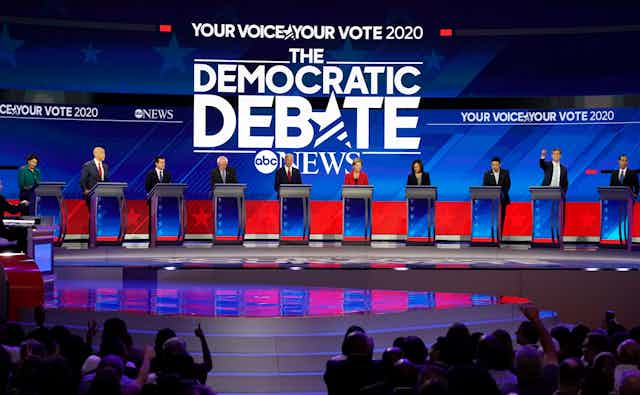Democratic presidential contenders gathered Tuesday evening in Ohio for the latest in a series of televised question-and-answer sessions in the lead-up to the 2020 primary season.
These sessions are called debates by their sponsors and the participants. But are they really?
Presidential debate scholars have long lamented that presidential debates are not really debates at all, but canned mini-speeches at what amounts to a joint press conference.
According to authors Austin Freeley and David Steinberg, “Debate is the process of inquiry and advocacy, a way of arriving at a reasoned judgment on a proposition.” The literature on what constitutes that process is wide and varied, but there are widely acknowledged essential elements in that process.
Engage and argue
I am a communications scholar who directs the debate program at Vanderbilt University. Here’s what I teach my students about debate.
First, the process involves participants engaging each other on a specific topic. They must answer and question each other’s arguments.
Second, it involves arguments for and against a given proposition related to a topic. For example, college debaters may debate a proposition such as: The United States federal government should substantially increase statutory restrictions on the war power authority of the president of the United States.
Finally, these arguments occur within an agreed-upon format that gives participants a chance to advocate for and defend their opinions. Format considerations that encourage direct argumentation and engagement include time limits, the ability to offer a rebuttal to an opponent’s arguments and cross-examination by participants.
If this all occurs, then an audience can potentially reach a reasoned judgment on the topic.
These are the essential elements of a debate.
Lack of specifics
Yet in the presidential debates of the last half-century, rarely are specific propositions presented as the focus of the debate.
Presidential rhetoric expert Theodore Windt says that in the 1960 presidential debates, “The candidates wanted only broad topics to be discussed… They did not want to debate specific propositions of policy… They would not really debate, either in format or form, but would answer questions from journalists about a wide range of topics.”
That lack of focus has persisted to this day. So presidential debates are not really debates because presidential candidates answer wide-ranging and broad questions, not specific propositions.
And because candidates are answering questions from journalists, they are often not engaging each other. Instead, they focus on responding to the moderator and playing to the audience.
For instance, MSNBC co-moderator Savannah Guthrie asked candidates at the June 27, 2019, debate, “Raise your hand if your government [health care] plan would provide coverage for undocumented immigrants.” That kind of question focused on engagement between candidates and the moderator, rather than between candidates.
The end result of these now-normalized conventions is that they make it hard to deeply discuss serious issues. Instead, this kind of format promotes the use of candidates’ focus-group tested messaging, “one-liners and canned mini-speeches.” There is little back and forth between candidates. Viewers hear monologue, not debate.
Critical thinking
One of the assumed benefits of Western-style debate is that it is educational to those listening. Research shows that viewers do learn about candidate platforms during debates.
However, learning more about candidate platforms isn’t always the same as learning more about the pros and cons of a given issue or approach.
In short, this style of presidential debates may help voters identify which candidate shares their views, but they do not help them think critically about those views.

